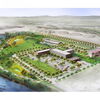On the trail | Snowmobiling is big business in northern Maine, but the industry is at a crossroads
Zooming along at 60 miles an hour on a stretch of Aroostook County's 2,300 miles of snowmobile trails doesn't give a rider much time to read the small trailside signs advertising nearby restaurants, stores and gas stations. "Rendezvous Restaurant, this way." "Gas, 10 miles." For these businesses, trailside signs are as critical during the winter months as roadside signs are the rest of the year.
Indeed, snowmobiling has become an integral part of Aroostook County's winter tourism industry, contributing millions of dollars to the economy and creating ripple effects that can be felt long after the snow melts.
Snowmobiling is big throughout Maine, but Aroostook County often stands above the rest because its snowfall usually starts early and ends late. It also boasts an extensive, 2,300-mile network of groomed snowmobile trails, plus connections to another 1,500 miles across the border in Canada. Residents of the County claim other intangibles, like the area's hospitality and snowmobile-friendly communities, are a big draw.
The larger snowmobile world has also taken notice. In its March issue, SnowGoer magazine, based in Maple Grove, Minn., listed Aroostook County eighth on its list of the top 10 snowmobiling destinations in North America, placing it among such venerable destinations as Michigan's Upper Peninsula, the West Yellowstone area of Montana and Quebec's Gaspe Peninsula.
In total, snowmobiling has an estimated $350 million impact on Maine's economy, which places it about even with the economic impact of Maine's ski industry, according to Bob Meyers, executive director of the Maine Snowmobile Association. In Aroostook County, the snowmobiling industry is credited with bringing in $17 million annually in restaurant and lodging tax revenue, but that figure doesn't include the sale of gas, groceries and gear to snowmobilers.
But there's a big difference between the two winter sports: While the ski industry is supported by private vendors — and lots of private money — the snowmobiling industry is carried largely on the back of volunteers. It is the 38 snowmobile clubs in Aroostook County and their members who often own the trail groomers, which can cost upwards of $200,000, and spend many a cold night grooming trails so locals and tourists can enjoy sledding in the County. "Depending on your perspective, that's really cool or really scary," Meyers jokes.
"You have to take your hats off to them," says David Spooner, who's in charge of tourism initiatives for the Northern Maine Development Commission in Caribou. "If they didn't do what they do, we wouldn't sit as number eight in North America for snowmobiling." And businesses would be missing a lot of business during the winter.
But despite the recent record-setting winter that dropped 197 inches of snow on parts of Aroostook County, there are weaknesses in the industry's foundation that, left unchecked, threaten the growth of snowmobiling in Maine. For starters, snowmobile clubs had to start grooming the trails several weeks earlier than usual and many ran through their budgets much earlier in the season. Second, because it was such a snowy winter throughout the state, fewer snowmobilers felt compelled to travel to Aroostook County when they could go sledding closer to home. Spooner says overall this will prove to be a good year because Aroostook County will have snow longer than other places, but so far it hasn't been stellar. "The perfect storm for us is when we have snow and no one else does," Spooner says.
An economic spark plug
On an average Saturday or Sunday during the winter, a sea of 200 snowmobiles will be parked outside the Lakeview Restaurant in St. Agatha, a small town on the crown of Maine, just a few miles from the Canadian border. During the winter, 80% of the restaurant's business comes in the form of snowmobilers clad in snow pants and thick jackets, says Jenn Daigle, who manages the restaurant with her sister Lisa Derosier. "If there wasn't snowmobiling, we wouldn't be open in the winter," she says.
Lakeview is a well-known destination for snowmobilers in northern Maine. It's perched on a hill with a view overlooking Long Lake, itself a major corridor for snowmobilers during the winter. But the restaurant's major attribute is its prime location on Interconnected Trail System 83, a major artery of Aroostook County's snowmobile trail system, at a place where several other trails merge.
But the snowmobile industry in northern Maine is such a web of interconnections that a kink in one place can be felt elsewhere. Fewer available lodging rooms mean fewer sledders on the trails and fewer sledders spending money in area restaurants and stores. Kevin Freeman, who owns The Sled Shop, a snowmobile outfitter and repair shop in Presque Isle, says he's seen the ripple effect if a hotel in the area has had to close for a weekend.
That's largely because Aroostook County has become a true destination for snowmobilers. Roughly 20% of the 95,553 snowmobile registrations this year were held by non-residents. That compares to 13.5% out-of-state registrants 10 years ago. "What's changed over the last 10 years is more and more people have heard of the hospitality and services offered in this region, and now they'll drive further and further distances to get here," Freeman says, adding that 80% of his customers travel more than 100 miles to The Sled Shop.
To cater to snowmobilers, groups like the Northern Maine Development Commission are making efforts to improve the entire industry. The group is putting the finishing touches on a digital GPS-generated map of Aroostook County's 2,300 miles of snowmobile trails. The map will work with the Google Earth platform, which integrates Aroostook County with Google's data of where food and lodging is located.
Initially, the GPS-mapped trail system will be available for free on Aroostook County's tourism website, www.visitaroostook.com, hopefully by the next winter season. But Spooner hopes snowmobilers will eventually be able to download it for a fee straight to the GPS units they carry on the trail. He expects that service to be available within the next two to three years. "We have the data, we just need to be able to supply it to people in a way they can use it," Spooner says.
Snowmobiling is a boon for the tourism industry, but it can also be used as a tool for economic development. Robert Clark, NMDC's executive director, and Walt Elish, president and CEO of Aroostook Partnership for Progress, use snowmobiling as a business attraction tool. While other areas may try to woo business execs with tickets to big-time shows or sporting events, Clark and Elish offer snowmobiling trips in the County to site location specialists or business officials they're trying to attract. The trips haven't created any direct results, but Elish says he has faith. "The more people we bring in, the better chance we have of landing companies," he says.
Fork in the road
But this winter's success also exposed the fragility of a system that is highly dependent on volunteer work. The state's current funding formula reimburses snowmobile clubs at the end of the year through a grant program administered by the Maine Department of Conservation. The funds, about $3 million annually, come from a percentage of snowmobile registration fees, plus a small percentage of the state's gasoline tax — close to one half of one percent. "These days we're grateful just to have it," says Meyers at the MSA.
But Meyers says the system, which hasn't been touched since the 1980s, has reached a breaking point and needs to be modernized. "The grant program is antiquated and the whole system needs to be revisited at this point," Meyers says. "Over the years we've thrown Band-Aids on things, through fee increases and things like that, but I think there's a consensus at this point that there needs to be a sustainable model for funding and to get this work done."
During the most recent legislative session, Meyers helped push through a bill that increased annual snowmobile registration fees from $33 to $35 for residents and $68 to $88 for non-residents. By comparison, a nonresident who wants to sled in Quebec pays $250 in seasonal registration fees. New Hampshire also has an additional fee for residents or nonresidents who want to register a sled but aren't members of a snowmobile club. The fee for a nonresident is $63 if they are also member of a club, but $93 for a nonresident non-club member. "For what we charge for a fee compared to other places, it's an extraordinary bargain," Meyers says.
Caribou has been held up by the Department of Conservation as a possible model for how the snowmobile industry could be managed in the future. The city owns the two groomers, pays the snowmobile club members to groom the trails and allocates $20,000 a year for equipment costs. But the snowmobile club members form an 18-member snowmobile advisory committee that makes all the decisions, such as when it's time to buy a new groomer. The city has been doing it this way since 1978, says Kathy Mazzuchelli, the superintendent of Caribou's park and recreation department and chair of the Maine State Trails Advisory Committee.
She agrees that the system that supports the snowmobile industry needs an overhaul or the industry will face a rough future. "Here comes a year with huge amounts of snow and huge amounts of fiscal impact for gas and maintenance costs and we're just being able to make this year go," Mazzuchelli says, adding that she hopes this year's good snow conditions will bring an increase in registrations and, therefore, an increase in the funds for the clubs. "But, wow, that's an awful way to run a business, at least in an industry this big."
Without the snowmobile clubs and the grooming they do, the 13,000 miles of trails in Maine would start to degrade and businesses would see a drop off in snowmobiler-generated sales.
The responsibility to maintain the quality of the snowmobile trails shouldn't fall purely on the backs of the clubs, which don't see any financial gain, says Mazzuchelli. "It's the businesses that get the end product," she says. "So everybody has to work together to try to make [the trail system] marketable, but make it reasonable for people involved in the snowmobile clubs."
A winter like this is a boon for businesses like St. Agatha's Lakeview Restaurant. "I'm ready for the snow to be gone," Daigle says. "But, businesswise, we've been crying for this for five years."
It's impossible to tell whether Aroostook County will see another record snowfall next year, or whether it will see an early spring. However, it's safe to assume that whatever snow Aroostook County does see next winter, it will have it later than the backyards of snowmobile enthusiasts in southern Maine and the rest of the northeastern United States, which is exactly what business owners in the County are counting on.









Comments